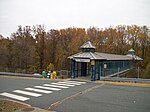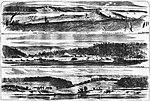Leesylvania (plantation)
Leesylvania was a plantation and historic home in Prince William County, Virginia, now part of Leesylvania State Park. During the 18th century, it was the home of Henry Lee II, his family and numerous slaves, and known for its productive land and especially the quality of its tobacco. Lee's sons Henry "Light-Horse Harry" Lee, Richard Bland Lee and Charles Lee, held prominent positions in Virginia during the American Revolutionary War and early federal government.Today, only a small portion of the foundation of the house remains, due to road construction in the 1950s. Lee and his wife are buried on the property (the family cemetery accessible by trail), but their headstones were moved to the Union Cemetery in Leesburg in 1969. The Leesylvania Archeological Site was listed on the National Register of Historic Places in 1984.
Excerpt from the Wikipedia article Leesylvania (plantation) (License: CC BY-SA 3.0, Authors).Leesylvania (plantation)
Neabsco Beach Way,
Geographical coordinates (GPS) Address Nearby Places Show on map
Geographical coordinates (GPS)
| Latitude | Longitude |
|---|---|
| N 38.5896077 ° | E -77.2585091 ° |
Address
Leesylvania State Park
Neabsco Beach Way
22191
Virginia, United States
Open on Google Maps







